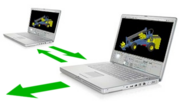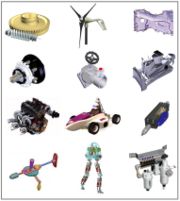Difference between revisions of "Open collaborative design"
(→Vast libraries of component parts and assemblies freely available) |
|||
| Line 1: | Line 1: | ||
| − | + | {{portalpage}} | |
| − | + | <!-- ****** TOP FRAME ****** --> | |
| + | <div style="float:right; width:100%;"> | ||
| + | {{frame1|Intro}} | ||
| + | {{frame1|Sections}} | ||
| + | </div> | ||
| − | = | + | <!-- ******* START OF LEFT COLUMN ******* --> |
| − | + | <div style="float:left; width:50%;"> <!-- This width add to the the margin below to equal 100%--> | |
| + | {{frame1|Beyond software}} | ||
| + | {{frame1|Suitable CAD software}} | ||
| + | {{frame1|Turning collaborative designs into real objects}} | ||
| + | </div> | ||
| − | + | <!-- ******* START OF RIGHT COLUMN ******* --> | |
| + | <div style="float:right; width:49%"> <!-- This margin should be right of the above --> | ||
| + | {{frame1|Open Source methodology applied to physical world}} | ||
| + | {{frame1|Vast libraries of machines and components}} | ||
| + | {{frame1|Open source software}} | ||
| + | {{frame1|Other}} | ||
| + | </div> | ||
| − | + | {{portalpageend}} | |
| − | + | ||
| − | + | ||
| − | + | ||
| − | + | ||
| − | + | ||
| − | + | ||
| − | + | ||
| − | + | ||
| − | + | ||
| − | + | ||
| − | + | ||
| − | + | ||
| − | + | ||
| − | + | ||
| − | + | ||
| − | + | ||
| − | + | ||
| − | + | ||
| − | + | ||
Revision as of 00:43, 11 September 2006
|
Open collaborative design involves applying principles from the remarkable free and open-source software movement that provides a powerful new way to design physical objects, machines and systems. All information involved in creating the object or system is made available on the Internet – such as text, drawings, photographs and 3D computer-aided design (CAD) models – so that other people can freely re-create it, or help contribute to its further evolution. It is essentially the same principle that is used to progress scientific knowledge, however in reality it is much more open and transparent than much of contemporary scientific research.
A core element of this development model is a principle called 'copyleft' Open collaborative design is a nascent field that has huge potential to radically alter the way we create goods, machines and systems – not only for personal items but all the way up to components of national or global infrastructure.
With many people contributing to open design projects, as happens currently with software, a universal commons will emerge made up of vast libraries of designs for everything from components and sub-assemblies through to complete artefacts, machines and complex systems, available for anyone to download and incorporate into their own designs, or help evolve as part of a wider project.
As in software, it would be useful for components and assemblies to be as 're-usable' as possible in the sense of being able to be incorporated in many different machine designs. To aid this it should be possible to specify the vital dynamic functions of a component or assembly in the CAD software, so that it can easily be modified in shape and scale so it can be incorporated into a new design while ensuring it still works correctly. This will enable a huge reduction in duplication of effort and allow people to focus their efforts on creating new machines of increasing complexity and building on the work of others. One interesting side-effect of open collaboration is that it tends to lead to highly modular design. FireFox and Linux are examples of this. Modularity also leads to a high degree of reusability; someone designing a new piece of hardware or software can pick-and-mix parts of existing projects. This works well in software, but may have to be abstracted somewhat to work in physical systems where dimensions are obviously important to fit with other components. |
 [print version]
[print version]  [update]
[update]  [site map]
[site map]

